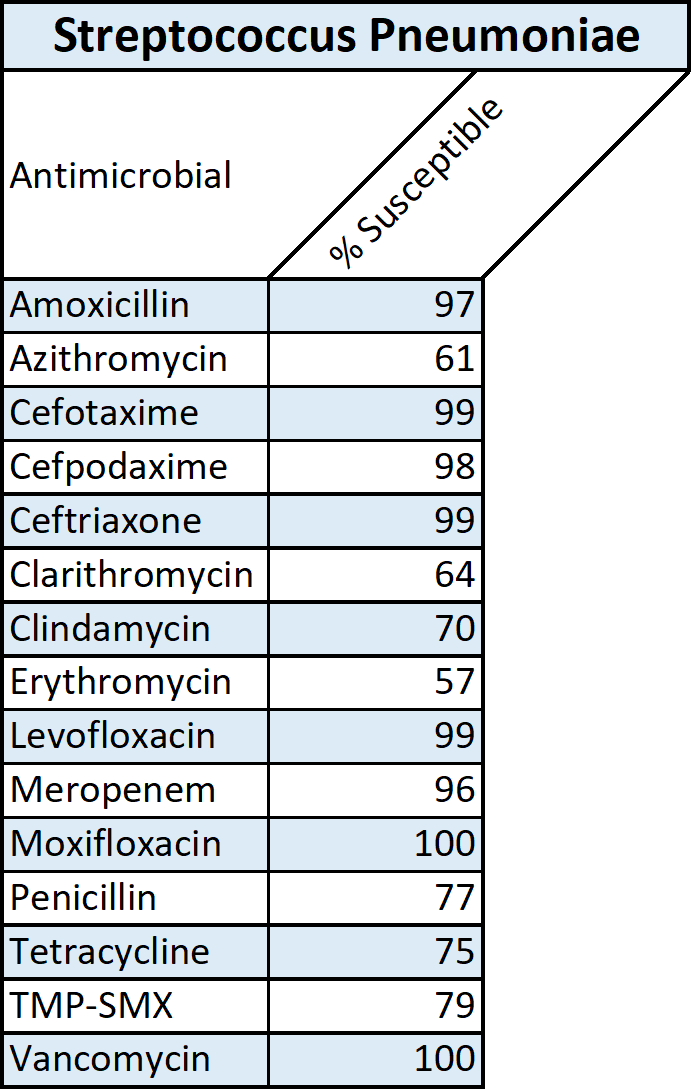[1]
Luna CM, Pulido L, Niederman MS, Casey A, Burgos D, Leiva Agüero SD, Grosso A, Membriani E, Entrocassi AC, Rodríquez Fermepin M, Vay CA, Garcia S, Famiglietti A. Decreased relative risk of pneumococcal pneumonia during the last decade, a nested case-control study. Pneumonia (Nathan Qld.). 2018:10():9. doi: 10.1186/s41479-018-0053-6. Epub 2018 Sep 25
[PubMed PMID: 30263884]
Level 2 (mid-level) evidence
[2]
Cillóniz C, Dominedò C, Garcia-Vidal C, Torres A. Community-acquired pneumonia as an emergency condition. Current opinion in critical care. 2018 Dec:24(6):531-539. doi: 10.1097/MCC.0000000000000550. Epub
[PubMed PMID: 30239410]
Level 3 (low-level) evidence
[3]
Shoji H, Vázquez-Sánchez DA, Gonzalez-Diaz A, Cubero M, Tubau F, Santos S, García-Somoza D, Liñares J, Yuste J, Martí S, Ardanuy C. Overview of pneumococcal serotypes and genotypes causing diseases in patients with chronic obstructive pulmonary disease in a Spanish hospital between 2013 and 2016. Infection and drug resistance. 2018:11():1387-1400. doi: 10.2147/IDR.S165093. Epub 2018 Sep 4
[PubMed PMID: 30214260]
Level 3 (low-level) evidence
[4]
Regev-Yochay G,Chowers M,Chazan B,Gonzalez E,Gray S,Zhang Z,Pride M, Distribution of 13-Valent pneumococcal conjugate vaccine serotype streptococcus pneumoniae in adults 50 Years and Older presenting with community-acquired pneumonia in Israel. Human vaccines
[PubMed PMID: 30188760]
[5]
Quah J, Jiang B, Tan PC, Siau C, Tan TY. Impact of microbial Aetiology on mortality in severe community-acquired pneumonia. BMC infectious diseases. 2018 Sep 4:18(1):451. doi: 10.1186/s12879-018-3366-4. Epub 2018 Sep 4
[PubMed PMID: 30180811]
[6]
Ghaffar F, Friedland IR, McCracken GH Jr. Dynamics of nasopharyngeal colonization by Streptococcus pneumoniae. The Pediatric infectious disease journal. 1999 Jul:18(7):638-46
[PubMed PMID: 10440444]
[7]
Alqahtani AS, Tashani M, Ridda I, Gamil A, Booy R, Rashid H. Burden of clinical infections due to S. pneumoniae during Hajj: A systematic review. Vaccine. 2018 Jul 16:36(30):4440-4446. doi: 10.1016/j.vaccine.2018.04.031. Epub 2018 Jun 20
[PubMed PMID: 29935859]
Level 1 (high-level) evidence
[8]
Wahl B, O'Brien KL, Greenbaum A, Majumder A, Liu L, Chu Y, Lukšić I, Nair H, McAllister DA, Campbell H, Rudan I, Black R, Knoll MD. Burden of Streptococcus pneumoniae and Haemophilus influenzae type b disease in children in the era of conjugate vaccines: global, regional, and national estimates for 2000-15. The Lancet. Global health. 2018 Jul:6(7):e744-e757. doi: 10.1016/S2214-109X(18)30247-X. Epub
[PubMed PMID: 29903376]
[9]
Boeddha NP, Schlapbach LJ, Driessen GJ, Herberg JA, Rivero-Calle I, Cebey-López M, Klobassa DS, Philipsen R, de Groot R, Inwald DP, Nadel S, Paulus S, Pinnock E, Secka F, Anderson ST, Agbeko RS, Berger C, Fink CG, Carrol ED, Zenz W, Levin M, van der Flier M, Martinón-Torres F, Hazelzet JA, Emonts M, EUCLIDS consortium. Mortality and morbidity in community-acquired sepsis in European pediatric intensive care units: a prospective cohort study from the European Childhood Life-threatening Infectious Disease Study (EUCLIDS). Critical care (London, England). 2018 May 31:22(1):143. doi: 10.1186/s13054-018-2052-7. Epub 2018 May 31
[PubMed PMID: 29855385]
[10]
Bellew S, Grijalva CG, Williams DJ, Anderson EJ, Wunderink RG, Zhu Y, Waterer GW, Bramley AM, Jain S, Edwards KM, Self WH. Pneumococcal and Legionella Urinary Antigen Tests in Community-acquired Pneumonia: Prospective Evaluation of Indications for Testing. Clinical infectious diseases : an official publication of the Infectious Diseases Society of America. 2019 May 30:68(12):2026-2033. doi: 10.1093/cid/ciy826. Epub
[PubMed PMID: 30265290]
[11]
Ishiguro T, Yoshii Y, Kanauchi T, Hoshi T, Takaku Y, Kagiyama N, Kurashima K, Takayanagi N. Re-evaluation of the etiology and clinical and radiological features of community-acquired lobar pneumonia in adults. Journal of infection and chemotherapy : official journal of the Japan Society of Chemotherapy. 2018 Jun:24(6):463-469. doi: 10.1016/j.jiac.2018.02.001. Epub 2018 Mar 28
[PubMed PMID: 29605556]
[12]
Osowicki J,Steer AC, International survey of paediatric infectious diseases consultants on the management of community-acquired pneumonia complicated by pleural empyema. Journal of paediatrics and child health. 2018 Jul 27
[PubMed PMID: 30051535]
Level 3 (low-level) evidence
[13]
Jakhar SK, Pandey M, Shah D, Ramachandran VG, Saha R, Gupta N, Gupta P. Etiology and Risk Factors Determining Poor Outcome of Severe Pneumonia in Under-Five Children. Indian journal of pediatrics. 2018 Jan:85(1):20-24. doi: 10.1007/s12098-017-2514-y. Epub 2017 Oct 13
[PubMed PMID: 29027126]
[14]
Lewandowska K, Kuś J. [Community acquired pneumonia - treatment options according to the international recommendations]. Wiadomosci lekarskie (Warsaw, Poland : 1960). 2016:69(2 Pt 1):139-44
[PubMed PMID: 27421128]
[15]
Green C, Moore CA, Mahajan A, Bajaj K. A Simple Approach to Pneumococcal Vaccination in Adults. Journal of global infectious diseases. 2018 Jul-Sep:10(3):159-162. doi: 10.4103/jgid.jgid_88_17. Epub
[PubMed PMID: 30166816]
[16]
Herbert JA, Kay EJ, Faustini SE, Richter A, Abouelhadid S, Cuccui J, Wren B, Mitchell TJ. Production and efficacy of a low-cost recombinant pneumococcal protein polysaccharide conjugate vaccine. Vaccine. 2018 Jun 18:36(26):3809-3819. doi: 10.1016/j.vaccine.2018.05.036. Epub 2018 May 25
[PubMed PMID: 29778517]
[17]
Blot M, Pauchard LA, Dunn I, Donze J, Malnuit S, Rebaud C, Croisier D, Piroth L, Pugin J, Charles PE. Mechanical ventilation and Streptococcus pneumoniae pneumonia alter mitochondrial homeostasis. Scientific reports. 2018 Aug 6:8(1):11718. doi: 10.1038/s41598-018-30226-x. Epub 2018 Aug 6
[PubMed PMID: 30082877]

